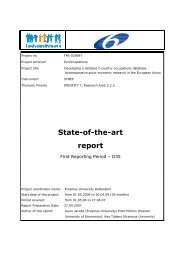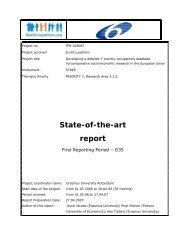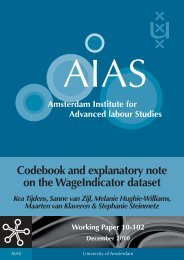- Page 1 and 2: Project no. FP6 FP6-028987 Project
- Page 3 and 4: Appendix ndix 2. Draft structure of
- Page 5 and 6: equipment used, materials worked on
- Page 7 and 8: ‘Armed forces’ is also split in
- Page 9: Table 4. Belgian NOC Major groups d
- Page 13 and 14: The first French national occupatio
- Page 15 and 16: is broken down by Spanish education
- Page 17 and 18: 7.1 Description of the Polish NOC T
- Page 19 and 20: organisations employing over 500 pe
- Page 21 and 22: (occupation groups) encompass the o
- Page 23 and 24: Embury, B., Gulati, J., Mata, A., &
- Page 25 and 26: Major group MAJOR Sub- Major group
- Page 27 and 28: Major group MAJOR Sub- Major group
- Page 29 and 30: Major group MAJOR Sub- Major group
- Page 31 and 32: Major group MAJOR Sub- Major group
- Page 33 and 34: Major group Sub- Major group State-
- Page 35 and 36: Major group Sub- Major group State-
- Page 37 and 38: Major group MAJOR Sub- Major group
- Page 39 and 40: ISCO 08 ISCO 88 Code Title Code Not
- Page 41 and 42: ISCO 08 Code Title 2242 Pharmacists
- Page 43 and 44: ISCO 08 ISCO 88 Code Title Code Not
- Page 45 and 46: ISCO 08 ISCO 88 Code Title Code Not
- Page 47 and 48: ISCO 08 Code Title 4141 Library and
- Page 49 and 50: ISCO 08 ISCO 88 Code Title Code Not
- Page 51 and 52: ISCO 08 Code Title 7234 Bicycle and
- Page 53 and 54: ISCO 08 ISCO 88 Code Title operator
- Page 55 and 56: ISCO 08 Code Title 941 Food prepara
- Page 57 and 58: NIS- code 1991 NIS- code 1981 (oude
- Page 59 and 60: NIS- code 1991 NIS- code 1981 (oude
- Page 61 and 62:
NIS- code 1991 NIS- code 1981 (oude
- Page 63 and 64:
NIS- code 1991 04 040 NIS- code 198
- Page 65 and 66:
NIS- code 1991 NIS- code 1981 (oude
- Page 67 and 68:
NIS- code 1991 061 NIS- code 1981 (
- Page 69 and 70:
NIS- code 1991 NIS- code 1981 (oude
- Page 71 and 72:
NIS- code 1991 077 NIS- code 1981 (
- Page 73 and 74:
NIS- code 1991 088 NIS- code 1981 (
- Page 75 and 76:
NIS- code 1991 NIS- code 1981 (oude
- Page 77 and 78:
NIS- code 1991 NIS- code 1981 (oude
- Page 79 and 80:
NIS- code 1991 NIS- code 1981 (oude
- Page 81 and 82:
NIS- code 1991 NIS- code 1981 (oude
- Page 83 and 84:
NIS- code 1991 NIS- code 1981 (oude
- Page 85 and 86:
NIS- code 1991 217 NIS- code 1981 (
- Page 87 and 88:
NIS- code 1991 NIS- code 1981 (oude
- Page 89 and 90:
NIS- code 1991 NIS- code 1981 (oude
- Page 91 and 92:
NIS- code 1991 NIS- code 1981 (oude
- Page 93 and 94:
NIS- code 1991 NIS- code 1981 (oude
- Page 95 and 96:
NIS- code 1991 NIS- code 1981 (oude
- Page 97 and 98:
NIS- code 1991 NIS- code 1981 (oude
- Page 99 and 100:
NIS- code 1991 NIS- code 1981 (oude
- Page 101 and 102:
NIS- code 1991 582 NIS- code 1981 (
- Page 103 and 104:
NIS- code 1991 NIS- code 1981 (oude
- Page 105 and 106:
NIS- code 1991 NIS- code 1981 (oude
- Page 107 and 108:
NIS- code 1991 NIS- code 1981 (oude
- Page 109 and 110:
NIS- code 1991 NIS- code 1981 (oude
- Page 111 and 112:
NIS- code 1991 NIS- code 1981 (oude
- Page 113 and 114:
NIS- code 1991 NIS- code 1981 (oude
- Page 115 and 116:
NIS- code 1991 NIS- code 1981 (oude
- Page 117 and 118:
NIS- code 1991 NIS- code 1981 (oude
- Page 119 and 120:
NIS- code 1991 NIS- code 1981 (oude
- Page 121 and 122:
NIS- code 1991 NIS- code 1981 (oude
- Page 123 and 124:
NIS- code 1991 729 NIS- code 1981 (
- Page 125 and 126:
NIS- code 1991 NIS- code 1981 (oude
- Page 127 and 128:
NIS- code 1991 NIS- code 1981 (oude
- Page 129 and 130:
NIS- code 1991 NIS- code 1981 (oude
- Page 131 and 132:
NIS- code 1991 759 NIS- code 1981 (
- Page 133 and 134:
NIS- code 1991 NIS- code 1981 (oude
- Page 135 and 136:
NIS- code 1991 NIS- code 1981 (oude
- Page 137 and 138:
NIS- code 1991 NIS- code 1981 (oude
- Page 139 and 140:
NIS- code 1991 NIS- code 1981 (oude
- Page 141 and 142:
NIS- code 1991 80 800 NIS- code 198
- Page 143 and 144:
NIS- code 1991 NIS- code 1981 (oude
- Page 145 and 146:
NIS- code 1991 NIS- code 1981 (oude
- Page 147 and 148:
NIS- code 1991 NIS- code 1981 (oude
- Page 149 and 150:
NIS- code 1991 NIS- code 1981 (oude
- Page 151 and 152:
NIS- code 1991 NIS- code 1981 (oude
- Page 153 and 154:
NIS- code 1991 NIS- code 1981 (oude
- Page 155 and 156:
NIS- code 1991 NIS- code 1981 (oude
- Page 157 and 158:
NIS- code 1991 NIS- code 1981 (oude
- Page 159 and 160:
NIS- code 1991 NIS- code 1981 (oude
- Page 161 and 162:
NIS- code 1991 NIS- code 1981 (oude
- Page 163 and 164:
NIS- code 1991 862 NIS- code 1981 (
- Page 165 and 166:
NIS- code 1991 NIS- code 1981 (oude
- Page 167 and 168:
NIS- code 1991 871 NIS- code 1981 (
- Page 169 and 170:
NIS- code 1991 891 NIS- code 1981 (
- Page 171 and 172:
NIS- code 1991 903 NIS- code 1981 (
- Page 173 and 174:
NIS- code 1991 NIS- code 1981 (oude
- Page 175 and 176:
NIS- code 1991 NIS- code 1981 (oude
- Page 177 and 178:
NIS- code 1991 NIS- code 1981 (oude
- Page 179 and 180:
NIS- code 1991 Z Z0 Z01 NIS- code 1
- Page 181 and 182:
SBC-1992 Code Werksoorten ISCO ISCO
- Page 183 and 184:
SBC-1992 Code Werksoorten ISCO ISCO
- Page 185 and 186:
SBC-1992 Code Werksoorten ISCO ISCO
- Page 187 and 188:
SBC-1992 Code Werksoorten ISCO ISCO
- Page 189 and 190:
SBC-1992 Code Werksoorten ISCO ISCO
- Page 191 and 192:
SBC-1992 Code Werksoorten ISCO ISCO
- Page 193 and 194:
SBC-1992 Code Werksoorten ISCO ISCO
- Page 195 and 196:
SBC-1992 Code Werksoorten ISCO ISCO
- Page 197 and 198:
SBC-1992 Code Werksoorten ISCO ISCO
- Page 199 and 200:
SBC-1992 Code Werksoorten ISCO ISCO
- Page 201 and 202:
SBC-1992 Code Werksoorten ISCO ISCO
- Page 203 and 204:
SBC-1992 Code Werksoorten ISCO ISCO
- Page 205 and 206:
SBC-1992 Code Werksoorten ISCO ISCO
- Page 207 and 208:
SBC-1992 Code Werksoorten ISCO ISCO
- Page 209 and 210:
SBC-1992 Code Werksoorten ISCO ISCO
- Page 211 and 212:
SBC-1992 Code Werksoorten ISCO ISCO
- Page 213 and 214:
SBC-1992 Code Werksoorten ISCO ISCO
- Page 215 and 216:
SBC-1992 Code Werksoorten ISCO ISCO
- Page 217 and 218:
SBC-1992 Code Werksoorten ISCO ISCO
- Page 219 and 220:
SBC-1992 Code Werksoorten ISCO ISCO
- Page 221 and 222:
SBC-1992 Code Werksoorten ISCO ISCO
- Page 223 and 224:
SBC-1992 Code Werksoorten ISCO ISCO
- Page 225 and 226:
Appendix 5a. a. French National Nat
- Page 227 and 228:
code 2003 382a Ingénieurs et cadre
- Page 229 and 230:
code 2003 462b Maîtrise de l'explo
- Page 231 and 232:
code 2003 524b Agents administratif
- Page 233 and 234:
code 2003 623a Chaudronniers-tôlie
- Page 235 and 236:
code 2003 653a Magasiniers qualifi
- Page 237 and 238:
Appendix 5b. Correspondence orrespo
- Page 239 and 240:
code 1982 3433 State-of-the-Art rap
- Page 241 and 242:
code 1982 State-of-the-Art rapport
- Page 243 and 244:
code 1982 3735 3742 3742 publiques
- Page 245 and 246:
code 1982 3828 3828 3828 3828 indus
- Page 247 and 248:
code 1982 énergie State-of-the-Art
- Page 249 and 250:
code 1982 State-of-the-Art rapport
- Page 251 and 252:
code 1982 4624 4624 4625 4626 State
- Page 253 and 254:
code 1982 4701 4702 State-of-the-Ar
- Page 255 and 256:
code 1982 State-of-the-Art rapport
- Page 257 and 258:
code 1982 4791 4791 4792 4792 4792
- Page 259 and 260:
code 1982 4881 4881 4882 4882 4883
- Page 261 and 262:
code 1982 des entreprises] State-of
- Page 263 and 264:
code 1982 5443 et du tourisme State
- Page 265 and 266:
code 1982 State-of-the-Art rapport
- Page 267 and 268:
code 1982 State-of-the-Art rapport
- Page 269 and 270:
code 1982 indication] State-of-the-
- Page 271 and 272:
code 1982 6264 State-of-the-Art rap
- Page 273 and 274:
code 1982 non industriels State-of-
- Page 275 and 276:
code 1982 State-of-the-Art rapport
- Page 277 and 278:
code 1982 State-of-the-Art rapport
- Page 279 and 280:
Appendix 5c. c. Correspondence Fren
- Page 281 and 282:
State-of-the-Art rapport PCS 2246 2
- Page 283 and 284:
State-of-the-Art rapport PCS 3838 3
- Page 285 and 286:
PCS 4731 4732 4733 4734 4735 4751 4
- Page 287 and 288:
PCS 4832 4832 4832 4832 4832 4832 4
- Page 289 and 290:
PCS 4861 4861 4861 4861 4861 4861 4
- Page 291 and 292:
PCS 4874 4874 4874 4874 4874 4874 4
- Page 293 and 294:
PCS 5444 5444 5444 5444 5444 5444 5
- Page 295 and 296:
PCS 6261 6261 6261 6261 6261 6261 6
- Page 297 and 298:
PCS 6522 6531 6532 6711 6721 6722 6
- Page 299 and 300:
PCS 6821 6821 6821 6821 6821 6821 6
- Page 301 and 302:
CNO-94 Code Label 1128 Dirección d
- Page 303 and 304:
CNO-94 Code Label 2058 Ingenieros g
- Page 305 and 306:
CNO-94 Code Label 2654 Ingenieros t
- Page 307 and 308:
CNO-94 Code Label 3131 Profesionale
- Page 309 and 310:
CNO-94 Code Label 43 Auxiliares adm
- Page 311 and 312:
CNO-94 Code Label 6022 Trabajadores
- Page 313 and 314:
CNO-94 Code Label 741 Encargados y
- Page 315 and 316:
CNO-94 Code Label 80 Jefes de equip
- Page 317 and 318:
CNO-94 Code Label 8352 Operadores d
- Page 319 and 320:
CNO-94 Code Label 9340 Lectores de
- Page 321 and 322:
CNO-94 Code CNO-94 Label 1042 Direc
- Page 323 and 324:
CNO-94 Code CNO-94 Label 1138 Direc
- Page 325 and 326:
CNO-94 Code CNO-94 Label State-of-t
- Page 327 and 328:
CNO-94 Code CNO-94 Label 2393 Procu
- Page 329 and 330:
CNO-94 Code CNO-94 Label químicos
- Page 331 and 332:
CNO-94 Code CNO-94 Label industrial
- Page 333 and 334:
CNO-94 Code CNO-94 Label 3311 Inter
- Page 335 and 336:
CNO-94 Code CNO-94 Label 3545 Depor
- Page 337 and 338:
CNO-94 Code CNO-94 Label 5010 Cocin
- Page 339 and 340:
CNO-94 Code CNO-94 Label State-of-t
- Page 341 and 342:
CNO-94 Code CNO-94 Label State-of-t
- Page 343 and 344:
CNO-94 Code CNO-94 Label State-of-t
- Page 345 and 346:
CNO-94 Code CNO-94 Label 7725 Encua
- Page 347 and 348:
CNO-94 Code CNO-94 Label instalacio
- Page 349 and 350:
CNO-94 Code CNO-94 Label instalacio
- Page 351 and 352:
CNO-94 Code CNO-94 Label 8365 Opera
- Page 353 and 354:
CNO-94 Code CNO-94 Label State-of-t
- Page 355 and 356:
Appendix 7. Polish National Occupat
- Page 357 and 358:
KZiS Code ISCO-88 Code KZiS Label 1
- Page 359 and 360:
KZiS Code ISCO-88 Code KZiS Label 2
- Page 361 and 362:
KZiS Code ISCO-88 Code KZiS Label 2
- Page 363 and 364:
KZiS Code ISCO-88 Code KZiS Label 2
- Page 365 and 366:
KZiS Code ISCO-88 Code KZiS Label 2
- Page 367 and 368:
KZiS Code ISCO-88 Code KZiS Label 2
- Page 369 and 370:
KZiS Code ISCO-88 Code KZiS Label 2
- Page 371 and 372:
KZiS Code ISCO-88 Code KZiS Label 2
- Page 373 and 374:
KZiS Code ISCO-88 Code KZiS Label 3
- Page 375 and 376:
KZiS Code ISCO-88 Code KZiS Label 3
- Page 377 and 378:
KZiS Code ISCO-88 Code KZiS Label 3
- Page 379 and 380:
KZiS Code ISCO-88 Code KZiS Label 3
- Page 381 and 382:
KZiS Code ISCO-88 Code KZiS Label 3
- Page 383 and 384:
KZiS Code ISCO-88 Code KZiS Label 3
- Page 385 and 386:
KZiS Code ISCO-88 Code KZiS Label 4
- Page 387 and 388:
KZiS Code ISCO-88 Code KZiS Label 5
- Page 389 and 390:
KZiS Code ISCO-88 Code KZiS Label 5
- Page 391 and 392:
KZiS Code ISCO-88 Code KZiS Label 7
- Page 393 and 394:
KZiS Code ISCO-88 Code KZiS Label 7
- Page 395 and 396:
KZiS Code ISCO-88 Code KZiS Label 7
- Page 397 and 398:
KZiS Code ISCO-88 Code KZiS Label 7
- Page 399 and 400:
KZiS Code ISCO-88 Code KZiS Label 7
- Page 401 and 402:
KZiS Code ISCO-88 Code KZiS Label 7
- Page 403 and 404:
KZiS Code ISCO-88 Code KZiS Label 7
- Page 405 and 406:
KZiS Code ISCO-88 Code KZiS Label 8
- Page 407 and 408:
KZiS Code ISCO-88 Code KZiS Label 8
- Page 409 and 410:
KZiS Code ISCO-88 Code KZiS Label 8
- Page 411 and 412:
KZiS Code ISCO-88 Code KZiS Label 8
- Page 413 and 414:
KZiS Code ISCO-88 Code KZiS Label 8
- Page 415 and 416:
KZiS Code ISCO-88 Code KZiS Label 8
- Page 417 and 418:
KZiS Code ISCO-88 Code KZiS Label 9
- Page 419 and 420:
KZiS Code ISCO-88 Code KZiS Label 9
- Page 421 and 422:
Major Group Sub- Major Group 12 Min
- Page 423 and 424:
Major Group Sub- Major Group 22 23
- Page 425 and 426:
Major Group Sub- Major Group 33 34
- Page 427 and 428:
Major Group 4 Sub- Major Group 41 4
- Page 429 and 430:
Major Group Sub- Major Group 54 Min
- Page 431 and 432:
Major Group 8 Sub- Major Group 72 8
- Page 433 and 434:
Major Group Sub- Major Group 92 Min
- Page 435 and 436:
Appendix 9. . German National Natio
- Page 437 and 438:
Kenn- ziffer ISCO-88 051 Gärtner/G
- Page 439 and 440:
Kenn- ziffer ISCO-88 101 Stein-, ,
- Page 441 and 442:
Kenn- ziffer ISCO-88 1453 8231 Konf
- Page 443 and 444:
Kenn- ziffer ISCO-88 1732 7343 Druc
- Page 445 and 446:
Kenn- ziffer ISCO-88 1941 8121 Verf
- Page 447 and 448:
Kenn- ziffer ISCO-88 2292 8211 Meta
- Page 449 and 450:
Kenn- ziffer ISCO-88 2559 7214 ande
- Page 451 and 452:
Kenn- ziffer ISCO-88 2760 7233 Indu
- Page 453 and 454:
Kenn- ziffer ISCO-88 3006 7222 Schl
- Page 455 and 456:
Kenn- ziffer ISCO-88 3134 7241 Elek
- Page 457 and 458:
Kenn- ziffer ISCO-88 3446 7332 Masc
- Page 459 and 460:
Kenn- ziffer ISCO-88 3710 7441 Gerb
- Page 461 and 462:
Kenn- ziffer ISCO-88 401 Fleischer/
- Page 463 and 464:
Kenn- ziffer ISCO-88 4410 7122 Maur
- Page 465 and 466:
Kenn- ziffer ISCO-88 4811 7133 Baus
- Page 467 and 468:
Kenn- ziffer ISCO-88 492 Polsterer/
- Page 469 and 470:
Kenn- ziffer ISCO-88 5121 7141 Ware
- Page 471 and 472:
Kenn- ziffer ISCO-88 5451 8332 Plan
- Page 473 and 474:
Kenn- ziffer ISCO-88 6045 2148 Beam
- Page 475 and 476:
Kenn- ziffer ISCO-88 6215 3115 Vers
- Page 477 and 478:
Kenn- ziffer ISCO-88 6316 3211 sons
- Page 479 and 480:
Kenn- ziffer ISCO-88 6616 5220 Büf
- Page 481 and 482:
Kenn- ziffer ISCO-88 676 Verkaufs--
- Page 483 and 484:
Kenn- ziffer ISCO-88 4133(N.SLBST.)
- Page 485 and 486:
Kenn- ziffer ISCO-88 7144 8324 Beru
- Page 487 and 488:
Kenn- ziffer ISCO-88 7414 4131 Thea
- Page 489 and 490:
Kenn- ziffer ISCO-88 757 Unternehme
- Page 491 and 492:
Kenn- ziffer ISCO-88 7764 2131 Leit
- Page 493 and 494:
Kenn- ziffer ISCO-88 7883 3431 Pers
- Page 495 and 496:
Kenn- ziffer ISCO-88 8037 3152 Sich
- Page 497 and 498:
Kenn- ziffer ISCO-88 833 Bildende K
- Page 499 and 500:
Kenn- ziffer ISCO-88 843 Tierärzte
- Page 501 and 502:
Kenn- ziffer ISCO-88 8631 3320 Erzi
- Page 503 and 504:
Kenn- ziffer ISCO-88 8763 3475 Skil
- Page 505 and 506:
Kenn- ziffer ISCO-88 8865 2445 Psyc
- Page 507 and 508:
Kenn- ziffer ISCO-88 9129 5123 ande
- Page 509:
Kenn- ziffer ISCO-88 9711 9910 Mith





